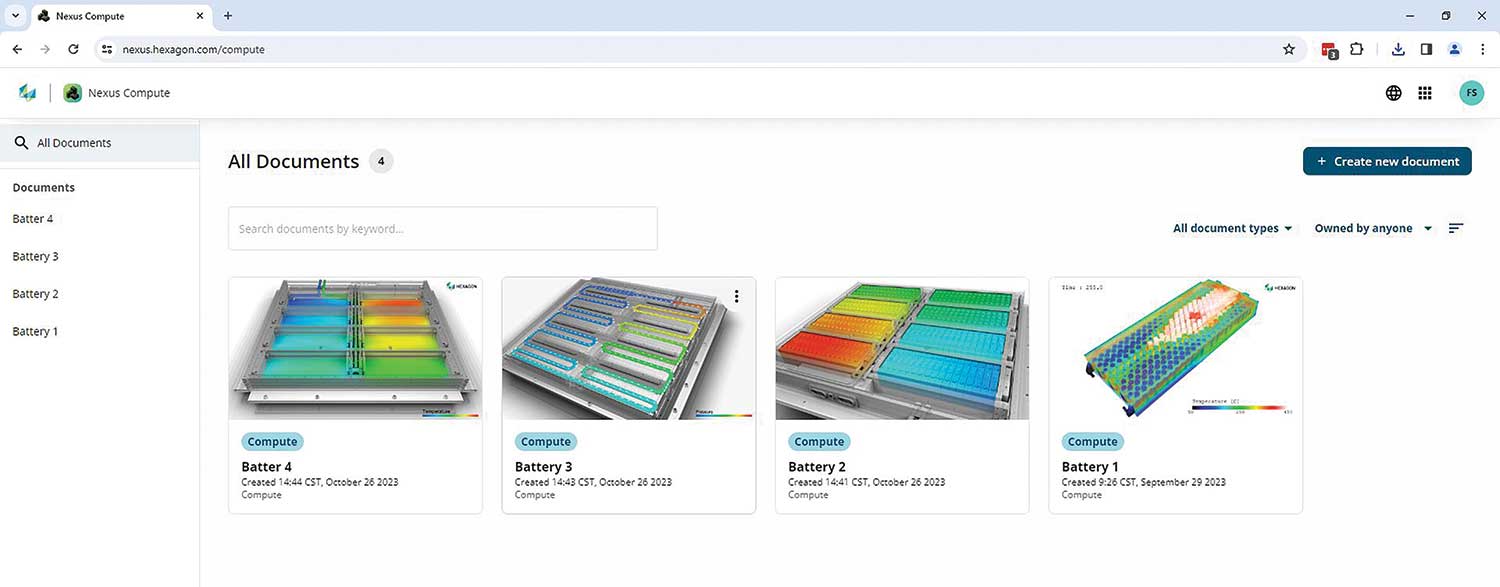Nexus Compute: Scalable cloud-based compute capability for engineering simulations
Hugues Jeancolas, Vice President, Product Management, Hexagon’s Manufacturing Intelligence division

Engineering Reality 2024 volume 1
Accelerate Smart Manufacturing
Over the past couple of decades, Computer Aided Engineering (CAE) has been a key enabler of product innovation, cutting down time-to-market and product development costs. In the race to virtualising prototype testing, the ability for product teams to conduct a greater number of simulations at an earlier stage in the design process has proven to be a significant competitive advantage.
Another significant challenge comes from the lack of flexibility of the self-managed HPC systems. Capital expenditures on machines and licenses force the teams to stick to a given hardware/ software configuration with only infrequent and partial upgrades. Purchase decisions often follow a lengthy process. This gives little opportunity for the team to quickly adopt to latest computer technology that could increase compute performance with the latest Graphics Processing Unit (GPU) or lower consumption/high-efficiency architectures such as ARM-based processors.
Small and Medium businesses (SMEs) and even start-ups are not immune to these challenges. In fact, they are further penalised as they often cannot afford the most powerful machines due to their prohibitive cost, and a computing need too small to justify the return on investment.
Of course, one should also note that maintaining an HPC centre comes with a non-negligible cost, operational challenges, and burden to the IT team managing it.
Nexus Compute addresses these issues by offering a cloud-based solution for engineering simulation.
Today’s Challenges
First, IT managers and CAE engineers are faced with managing a constantly varying workload with a fixed hardware capacity and a limited number of software licenses. This fluctuating demand, which at times leaves machines idle and at other times overwhelms compute servers, has forced engineering teams to resort to deploying a queuing system to ensure full utilisation of their hardware and software assets. While these systems somewhat improve throughput, they do not resolve the insurmountable issue of absorbing peak demand when this one exceeds either the hardware capacity or the availability of software licenses. The lack of compute power availability causes bottlenecks, which often result in product development delays.Another significant challenge comes from the lack of flexibility of the self-managed HPC systems. Capital expenditures on machines and licenses force the teams to stick to a given hardware/ software configuration with only infrequent and partial upgrades. Purchase decisions often follow a lengthy process. This gives little opportunity for the team to quickly adopt to latest computer technology that could increase compute performance with the latest Graphics Processing Unit (GPU) or lower consumption/high-efficiency architectures such as ARM-based processors.
Small and Medium businesses (SMEs) and even start-ups are not immune to these challenges. In fact, they are further penalised as they often cannot afford the most powerful machines due to their prohibitive cost, and a computing need too small to justify the return on investment.
Of course, one should also note that maintaining an HPC centre comes with a non-negligible cost, operational challenges, and burden to the IT team managing it.
Nexus Compute addresses these issues by offering a cloud-based solution for engineering simulation.

Figure 1. Nexus Compute enables to easily manage multiple projects.
Hexagon’s cloud compute solution
Cloud computing offers scalable and flexible hardware and software resource access. With Nexus Compute we are excited to bring our world-class engineering simulation software to the cloud, making it easier for our customers to access the tools they need to drive product innovation and improve their competitiveness.Nexus Compute is a cloud-native service delivered on Hexagon’s Nexus platform that provides users the ability to execute any number of simulations concurrently in a flexible, scalable, and secure environment. With Nexus Compute, engineers can easily launch simulations with only an internet connection and a few clicks. There is no need to invest in computing resources or software licenses to run engineering simulations. Nexus Compute is a Software as a Service (SaaS) offering with a consumption-based business model that requires an active Nexus account and pre-purchased Nexus Credits. No setup is needed, just log into Nexus and you are ready to work, focusing on design and engineering.
The computation leverages state-of-the-art hardware with a machine selection optimised for cost and speed. There is virtually no limit to the number of simulations engineers can run at one time, guaranteeing no bottlenecks. Today Nexus Compute already supports execution of the following solver technologies: MSC Nastran, Actran, Marc, and Cradle Software (scSTREAM and scFLOW).
Particularly for small and medium businesses (SME), Nexus Compute provides the ability to move simulations from their traditional desktop environment to large-scale HPC systems.
|
|
Desktop |
Nexus Compute (32 Cores, 448 GB RAM) |
|
Solver Run Time |
45m:09s |
6m:04s |
Table 1. Nexus Compute’s ~7x performance gains in solver run time over desktop.
The table shows the results of a benchmark running scFLOW Aircraft model with 14 million elements, demonstrating the scalability of the run time of Nexus Compute with one of typical desktop hardware for the same model.
Nexus Compute does not only give users access to more cores, more memory, and super-fast local storage (all ultimately contributing to positively impact compute performance for large models) but also provides infinitely elastic capacity allowing users to run as many jobs as needed at a time. This is especially useful when engineers will want to compare design alternatives or explore an entire design space and need to grab a large amount of compute resources at once. Of course, this use case is not even at all possible on the desktop.
“With MSC Nastran, it takes me only 1.5 hours of simulation time on Nexus Compute whereas it used to take 25 hours to run the same simulation on my 8-core laptop. Nexus Compute accelerates my development time by 6 or 7 times. This means the same amount of development time allows me to increase the coverage 5 to 6 times, leading to a robust design.”
Dzanko Hajradinovic
Senior Simulation Engineer
G&W Electric
The process is straightforward with an intuitive user interface. Users simply upload input files required to run the simulation, Nexus Compute automatically detects the input file format and suggests a set of recommended machine configurations and typical execution settings. A job submission is only one click away. Engineers can then monitor the execution of the simulation in real-time, review, and download the output file after completion for analysis.
Data managed on Nexus is organised in projects and documents to which access can be shared with other members of the same organisation. This allows multiple stakeholders and colleagues to share simulation models and results and collaborate on data that is centralised.
We have enjoyed an overwhelmingly positive response from our Nexus Compute pilot programme participants. Some see the potential to run much larger models at a moderate cost. Others envision scaling to many design variations and optimisation runs. Many are now looking into Nexus Compute as their solution to burst to cloud when in-house compute capacity is tapped out. What will you do with it?
Nexus Compute is available for use in Q4, 2023.
Visit nexus.hexagon.com for more details.
Data managed on Nexus is organised in projects and documents to which access can be shared with other members of the same organisation. This allows multiple stakeholders and colleagues to share simulation models and results and collaborate on data that is centralised.
We have enjoyed an overwhelmingly positive response from our Nexus Compute pilot programme participants. Some see the potential to run much larger models at a moderate cost. Others envision scaling to many design variations and optimisation runs. Many are now looking into Nexus Compute as their solution to burst to cloud when in-house compute capacity is tapped out. What will you do with it?
Nexus Compute is available for use in Q4, 2023.
Visit nexus.hexagon.com for more details.

Figure 2. An intuitive user interface to configure a simulation job.
Engineering Reality 2024 volume 1
Accelerate Smart Manufacturing